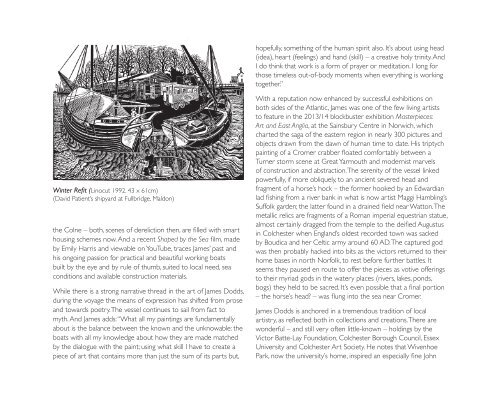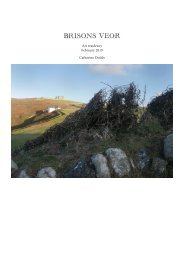woodtowater
Create successful ePaper yourself
Turn your PDF publications into a flip-book with our unique Google optimized e-Paper software.
hopefully, something of the human spirit also. It’s about using head<br />
(idea), heart (feelings) and hand (skill) – a creative holy trinity. And<br />
I do think that work is a form of prayer or meditation. I long for<br />
those timeless out-of-body moments when everything is working<br />
together.”<br />
Winter Refit (Linocut 1992. 43 x 61cm)<br />
(David Patient’s shipyard at Fullbridge, Maldon)<br />
the Colne – both, scenes of dereliction then, are filled with smart<br />
housing schemes now. And a recent Shaped by the Sea film, made<br />
by Emily Harris and viewable on YouTube, traces James’ past and<br />
his ongoing passion for practical and beautiful working boats<br />
built by the eye and by rule of thumb, suited to local need, sea<br />
conditions and available construction materials.<br />
While there is a strong narrative thread in the art of James Dodds,<br />
during the voyage the means of expression has shifted from prose<br />
and towards poetry. The vessel continues to sail from fact to<br />
myth. And James adds: “What all my paintings are fundamentally<br />
about is the balance between the known and the unknowable: the<br />
boats with all my knowledge about how they are made matched<br />
by the dialogue with the paint; using what skill I have to create a<br />
piece of art that contains more than just the sum of its parts but,<br />
With a reputation now enhanced by successful exhibitions on<br />
both sides of the Atlantic, James was one of the few living artists<br />
to feature in the 2013/14 blockbuster exhibition Masterpieces:<br />
Art and East Anglia, at the Sainsbury Centre in Norwich, which<br />
charted the saga of the eastern region in nearly 300 pictures and<br />
objects drawn from the dawn of human time to date. His triptych<br />
painting of a Cromer crabber floated comfortably between a<br />
Turner storm scene at Great Yarmouth and modernist marvels<br />
of construction and abstraction. The serenity of the vessel linked<br />
powerfully, if more obliquely, to an ancient severed head and<br />
fragment of a horse’s hock – the former hooked by an Edwardian<br />
lad fishing from a river bank in what is now artist Maggi Hambling’s<br />
Suffolk garden; the latter found in a drained field near Watton. The<br />
metallic relics are fragments of a Roman imperial equestrian statue,<br />
almost certainly dragged from the temple to the deified Augustus<br />
in Colchester when England’s oldest recorded town was sacked<br />
by Boudica and her Celtic army around 60 AD. The captured god<br />
was then probably hacked into bits as the victors returned to their<br />
home bases in north Norfolk, to rest before further battles. It<br />
seems they paused en route to offer the pieces as votive offerings<br />
to their myriad gods in the watery places (rivers, lakes, ponds,<br />
bogs) they held to be sacred. It’s even possible that a final portion<br />
– the horse’s head? – was flung into the sea near Cromer.<br />
James Dodds is anchored in a tremendous tradition of local<br />
artistry, as reflected both in collections and creations. There are<br />
wonderful – and still very often little-known – holdings by the<br />
Victor Batte-Lay Foundation, Colchester Borough Council, Essex<br />
University and Colchester Art Society. He notes that Wivenhoe<br />
Park, now the university’s home, inspired an especially fine John



